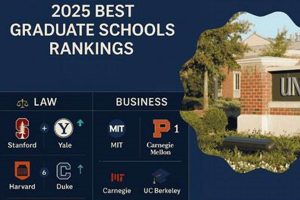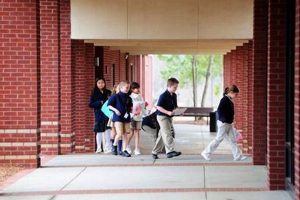Top-tier institutions specializing in aerospace engineering education offer rigorous programs combining theoretical knowledge with practical experience. These institutions often feature state-of-the-art facilities, including wind tunnels, flight simulators, and advanced laboratories. Graduates from such programs are typically well-prepared for careers in aircraft design, spacecraft development, propulsion systems, and related fields.
A strong aerospace engineering education is essential for driving innovation and advancement in the field. It equips individuals with the skills necessary to tackle complex challenges such as designing more fuel-efficient aircraft, developing sustainable space exploration technologies, and improving aircraft safety. Historically, advancements in aerospace engineering have been closely linked with prestigious educational institutions, highlighting their crucial role in shaping the industry’s future.
This article will delve into the factors to consider when selecting an aerospace program, explore prominent institutions known for their contributions to the field, and examine career pathways available to graduates.
Tips for Selecting an Aerospace Engineering Program
Choosing the right aerospace engineering program is a crucial step towards a successful career in the field. Careful consideration of several factors can help prospective students identify institutions best suited to their individual needs and aspirations.
Tip 1: Research Faculty Expertise: Investigate the research interests and publications of faculty members. A strong alignment between faculty expertise and a student’s own interests can lead to valuable mentorship and research opportunities.
Tip 2: Evaluate Facilities and Resources: Access to advanced facilities like wind tunnels, propulsion labs, and flight simulators is essential for a practical and comprehensive education. Consider the availability of computational resources and software relevant to aerospace engineering.
Tip 3: Consider Industry Connections: Institutions with strong ties to aerospace companies and government agencies often offer internships, co-op programs, and networking opportunities that can significantly enhance career prospects.
Tip 4: Explore Curricular Depth and Breadth: Review program curricula to ensure they offer a balanced foundation in fundamental aerospace principles as well as specialized courses in areas of interest such as aerodynamics, propulsion, or control systems. Look for opportunities to engage in design projects and hands-on experimentation.
Tip 5: Assess Program Accreditation: Accreditation by recognized bodies ensures that the program meets established quality standards and prepares graduates for professional practice.
Tip 6: Examine Alumni Outcomes: Research the career paths of program alumni. Information about job placement rates and the types of companies hiring graduates can provide insights into program effectiveness.
By carefully considering these factors, aspiring aerospace engineers can identify programs that provide the necessary knowledge, skills, and opportunities to thrive in this demanding and rewarding field. A well-chosen program serves as a strong foundation for a successful and impactful career.
The following section will provide a more detailed look at specific aerospace engineering programs known for their excellence and contributions to the field.
1. Reputation and Rankings
Reputation and rankings play a significant role in identifying leading aerospace engineering programs. A strong reputation often reflects a history of academic excellence, impactful research contributions, and successful alumni. Rankings, while subject to specific methodologies and criteria, aggregate various performance indicators, offering a comparative perspective on program strengths. These indicators can include faculty qualifications, research output, student selectivity, and industry recognition. Institutions consistently appearing at the top of reputable rankings frequently benefit from increased visibility, attracting high-achieving students and faculty, fostering a competitive academic environment. For example, institutions like the Massachusetts Institute of Technology (MIT) and the California Institute of Technology (Caltech) consistently maintain top rankings due to their rigorous academic standards, groundbreaking research, and extensive industry collaborations. Their reputations attract leading faculty and students, further enhancing their standing.
However, relying solely on rankings can be misleading. Program reputation encompasses factors beyond quantifiable metrics. The specific research focus of a department, the availability of specialized facilities, and the strength of alumni networks can significantly influence an individual’s educational experience and career prospects. A program renowned for its expertise in propulsion systems, for example, might be a better fit for a student interested in rocket design than a higher-ranked program with a broader focus. Therefore, prospective students should consider rankings as one factor among many when evaluating programs. Visiting campuses, attending webinars, and engaging with current students and faculty can provide valuable insights beyond published rankings.
In summary, reputation and rankings offer valuable, albeit imperfect, tools for assessing aerospace engineering programs. While rankings provide a useful starting point, a comprehensive evaluation should consider factors such as research alignment, faculty expertise, available resources, and career support services. A thorough investigation of these factors enables prospective students to identify programs best aligned with their individual goals and aspirations, paving the way for a fulfilling and impactful career in the aerospace industry.
2. Faculty Expertise
Faculty expertise stands as a cornerstone of any top-tier aerospace engineering program. Distinguished faculty members, often leaders in their respective research areas, bring cutting-edge knowledge and practical experience to the classroom. Their contributions extend beyond lectures, shaping research opportunities, mentoring students, and fostering a vibrant intellectual environment. The presence of renowned experts in fields like aerodynamics, propulsion, or control systems directly influences the quality and depth of education students receive. For instance, a program with faculty actively involved in NASA missions can offer students unique insights into space exploration challenges and opportunities. Similarly, a department specializing in hypersonic flight research can provide unparalleled expertise in this rapidly evolving area.
The impact of faculty expertise extends beyond the immediate learning experience. Faculty research activities often create opportunities for student involvement, providing hands-on experience with advanced technologies and research methodologies. This direct engagement with cutting-edge research can significantly enhance students’ understanding of complex engineering principles and prepare them for future careers in academia or industry. Furthermore, faculty connections within the aerospace industry can lead to valuable internships, collaborations, and career pathways for graduates. A professor collaborating with a major aerospace company can open doors for students seeking real-world experience and future employment. This symbiotic relationship between faculty expertise and industry connections strengthens the educational ecosystem and benefits both students and the broader aerospace community.
In conclusion, faculty expertise serves as a crucial differentiating factor among aerospace engineering programs. It directly influences the quality of education, shapes research opportunities, and fosters connections with the broader aerospace industry. Aspiring aerospace engineers should prioritize institutions with faculty actively engaged in cutting-edge research and possessing strong industry ties. This strategic approach can significantly enhance educational outcomes and pave the way for a successful and impactful career.
3. Research Opportunities
Robust research opportunities represent a defining characteristic of leading aerospace engineering programs. These opportunities provide students with invaluable practical experience, complementing theoretical coursework and fostering innovation. Engagement in research allows students to apply classroom knowledge to real-world challenges, developing critical thinking skills and contributing to the advancement of the field. The availability of cutting-edge facilities, funding opportunities, and faculty mentorship significantly influences the quality and impact of student research.
- Faculty-Led Research Projects
Participating in faculty-led research projects exposes students to diverse research areas, from advanced materials science to autonomous flight control. For example, a student might contribute to a project developing novel composite materials for lighter aircraft structures or work on algorithms for unmanned aerial vehicle navigation. These experiences provide practical skills, foster collaboration, and often lead to publications and conference presentations, strengthening students’ academic credentials.
- Independent Research Initiatives
Top aerospace programs often encourage students to pursue independent research projects, allowing them to explore specific areas of interest. This could involve designing and testing a new type of airfoil in a wind tunnel or developing software for satellite trajectory optimization. Such initiatives foster creativity, problem-solving skills, and a deeper understanding of the research process.
- Industry-Sponsored Research
Collaboration with industry partners provides research opportunities aligned with real-world engineering challenges. Students might work on projects sponsored by aerospace companies seeking to improve aircraft engine efficiency or develop new space propulsion technologies. These experiences offer valuable insights into industry practices and can lead to internships and future employment opportunities.
- Government-Funded Research
Many leading aerospace programs receive funding from government agencies like NASA, the Department of Defense, and the National Science Foundation. This funding supports research in areas of national importance, such as space exploration, national security, and sustainable aviation. Participating in government-funded research exposes students to large-scale projects, advanced technologies, and collaboration with leading researchers in the field.
The depth and breadth of research opportunities directly correlate with the quality of an aerospace engineering program. Access to state-of-the-art facilities, faculty mentorship, and diverse funding sources contribute significantly to a rich research environment. These experiences not only enhance students’ technical skills but also foster critical thinking, problem-solving abilities, and a passion for innovation, preparing them for successful careers in academia, industry, and government research laboratories.
4. Industry Connections
Strong industry connections are a hallmark of leading aerospace engineering programs. These partnerships provide a crucial link between academic learning and real-world application, enriching the educational experience and significantly enhancing career prospects for graduates. Collaborations with aerospace companies, government agencies, and research institutions offer students invaluable opportunities for practical experience, exposure to cutting-edge technologies, and networking with industry professionals. This symbiotic relationship benefits both the academic institutions and their industry partners, fostering innovation and driving advancements in the field.
- Internships and Co-op Programs
Internships and co-op programs offer students hands-on experience within aerospace companies, allowing them to apply classroom knowledge to real-world projects. For example, a student might intern at a major aircraft manufacturer, working on the design and testing of new wing structures, or contribute to software development for satellite control systems at a space agency. These experiences provide valuable insights into industry practices, foster professional development, and often lead to full-time employment opportunities after graduation. Institutions with established internship programs and strong industry partnerships often boast higher placement rates for their graduates.
- Industry-Sponsored Research and Development
Industry partnerships often lead to collaborative research and development projects. Companies seeking to innovate and develop new technologies frequently partner with universities, leveraging faculty expertise and student talent. This collaboration provides students with access to cutting-edge research, advanced facilities, and real-world problem-solving experience. For example, a student might participate in a project developing new materials for hypersonic aircraft, sponsored by a leading aerospace company. Such experiences offer invaluable training and can significantly enhance career prospects.
- Guest Lectures and Networking Events
Leading aerospace engineering programs frequently host guest lectures and networking events featuring industry professionals. These events offer students direct interaction with engineers, scientists, and executives from leading aerospace companies and agencies. Hearing firsthand accounts of current industry challenges and future trends provides valuable context for academic studies and exposes students to diverse career pathways. Networking opportunities at these events can lead to mentorship relationships and internships, further strengthening the connection between academia and industry.
- Career Placement and Alumni Networks
Strong industry connections translate into robust career placement services and active alumni networks. Universities with established relationships with aerospace companies often have dedicated career advisors who facilitate connections between graduating students and potential employers. Alumni networks provide another valuable resource, offering mentorship, career guidance, and access to job opportunities. A strong alumni presence within the industry can significantly enhance a graduate’s career prospects and provide ongoing professional support.
In conclusion, robust industry connections represent a crucial element of top-tier aerospace engineering programs. These partnerships provide a bridge between academic theory and real-world practice, enriching the educational experience and creating pathways to successful and impactful careers. The integration of internships, industry-sponsored research, networking opportunities, and strong alumni networks significantly enhances the value of an aerospace engineering degree and positions graduates for leadership roles within the field. By prioritizing institutions with strong industry ties, aspiring aerospace engineers invest in their future success and contribute to the ongoing advancement of the aerospace industry.
5. Facilities and Resources
State-of-the-art facilities and ample resources are integral components of leading aerospace engineering programs. Access to advanced equipment and technologies directly impacts the quality of education and research, providing students with practical, hands-on experience essential for success in this demanding field. Wind tunnels, for instance, allow students to study aerodynamic principles and test aircraft designs in controlled environments, bridging the gap between theoretical knowledge and practical application. Similarly, access to sophisticated simulation software enables the exploration of complex flight dynamics and control systems without the constraints of physical prototypes. Institutions investing in these resources demonstrate a commitment to providing a comprehensive and cutting-edge educational experience. The availability of advanced materials testing laboratories, propulsion test stands, and flight simulators further enhances the practical training students receive, preparing them for the challenges of a rapidly evolving industry. For example, students at institutions with access to supersonic wind tunnels gain firsthand experience with high-speed flight phenomena, a critical area of expertise for advanced aircraft and spacecraft development.
The impact of robust facilities extends beyond undergraduate education. Cutting-edge resources attract top faculty researchers, fostering a dynamic research environment and driving innovation in the field. Access to specialized equipment, such as high-performance computing clusters and advanced fabrication tools, allows faculty to pursue ambitious research projects, attracting external funding and producing groundbreaking results. This research-intensive environment benefits students through opportunities for direct involvement in cutting-edge projects, fostering collaboration and mentorship. Furthermore, well-equipped laboratories attract industry partnerships, creating pathways for internships, sponsored research, and technology transfer, ultimately benefiting both students and the broader aerospace community. For example, a university with a state-of-the-art composites manufacturing facility might attract partnerships with aerospace companies seeking to develop lighter and stronger aircraft components, offering students invaluable experience with advanced manufacturing processes.
In conclusion, access to sophisticated facilities and resources plays a critical role in distinguishing leading aerospace engineering programs. These resources directly enhance the quality of education, provide practical training, and foster a vibrant research environment. Institutions prioritizing investment in these areas cultivate a culture of innovation and equip students with the knowledge and skills necessary to excel in the competitive aerospace industry. The correlation between access to advanced resources and program reputation underscores the importance of considering these factors when evaluating prospective aerospace engineering programs. This careful consideration equips aspiring aerospace engineers with the tools and experiences necessary for a successful and impactful career.
Frequently Asked Questions about Top Aerospace Engineering Programs
This section addresses common inquiries regarding the selection and pursuit of education within top aerospace engineering programs.
Question 1: What distinguishes top aerospace engineering programs from others?
Leading programs are characterized by distinguished faculty actively engaged in cutting-edge research, state-of-the-art facilities, strong industry connections, and a commitment to providing students with practical experience through research opportunities and internships. A rigorous curriculum emphasizing both theoretical foundations and practical application is also essential.
Question 2: How important are program rankings when choosing an aerospace engineering school?
Rankings offer a useful starting point for program evaluation but should not be the sole deciding factor. Consider rankings alongside factors like faculty expertise, research areas, available resources, and career support services to ensure alignment with individual academic and career goals.
Question 3: What are the typical admission requirements for top aerospace engineering programs?
Competitive applicants generally possess a strong academic background in mathematics and science, demonstrated through high GPA scores and standardized test results. Letters of recommendation highlighting academic potential and relevant experience, along with a compelling statement of purpose articulating research interests and career aspirations, are also crucial.
Question 4: What career opportunities are available to graduates of top aerospace engineering programs?
Graduates are well-prepared for diverse career paths within the aerospace industry, including positions in aircraft design and manufacturing, spacecraft development, propulsion systems engineering, and research and development. Opportunities also exist within government agencies like NASA and within the defense sector.
Question 5: What are the key factors to consider when choosing between different aerospace engineering programs?
Consider factors such as faculty research interests and expertise, available facilities and resources, industry connections and internship opportunities, curriculum depth and breadth, program reputation and alumni network, and location and cost of living. Aligning these factors with individual preferences and career aspirations is essential.
Question 6: How can prospective students gain more insights into specific aerospace engineering programs?
Visiting campuses, attending virtual information sessions, and engaging with current students and faculty offer valuable firsthand perspectives beyond published information. Reviewing faculty research publications and exploring program websites provide further insights into research areas and available resources.
Careful consideration of these factors empowers prospective students to make informed decisions about pursuing aerospace engineering education. Thorough research and proactive engagement contribute significantly to selecting the program best suited to individual needs and aspirations.
The subsequent section will explore further resources and information pertinent to pursuing a career in aerospace engineering.
Conclusion
Elite aerospace engineering programs represent a critical investment in the future of the field. Careful consideration of factors such as faculty expertise, research opportunities, industry connections, and available resources is paramount when selecting a program. These institutions cultivate the next generation of aerospace innovators, equipping graduates with the skills and knowledge necessary to address complex challenges and advance the frontiers of flight and space exploration. A thorough evaluation of these factors empowers aspiring aerospace engineers to identify programs best aligned with individual aspirations and career goals.
The pursuit of excellence in aerospace engineering education demands dedication, rigorous study, and a passion for innovation. Graduates of top-tier programs are poised to make significant contributions to the field, shaping the future of air and space travel. The ongoing demand for skilled aerospace engineers underscores the importance of investing in high-quality education and fostering a collaborative environment where innovation thrives. The future of aerospace rests upon the shoulders of well-prepared graduates, ready to tackle the complex challenges and exciting opportunities that lie ahead.







